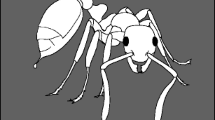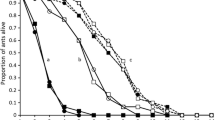Abstract
The ability to detoxify defensive compounds of competitors provides key ecological advantages that can influence community-level processes. Although common in plants and bacteria, this type of detoxification interaction is extremely rare in animals. Here, using laboratory behavioral assays and analyses of videotaped interactions in South America, we report widespread venom detoxification among ants in the subfamily Formicinae. Across both data sets, nine formicine species, representing all major clades, used a stereotyped grooming behavior to self-apply formic acid (acidopore grooming) in response to fire ant (Solenopsis invicta and S. saevissima) venom exposure. In laboratory assays, this behavior increased the survivorship of species following exposure to S. invicta venom. Species expressed the behavior when exposed to additional alkaloid venoms, including both compositionally similar piperidine venom of an additional fire ant species and the pyrrolidine/pyrroline alkaloid venom of a Monomorium species. In addition, species expressed the behavior following exposure to the uncharacterized venom of a Crematogaster species. However, species did not express acidopore grooming when confronted with protein-based ant venoms or when exposed to monoterpenoid-based venom. This pattern, combined with the specific chemistry of the reaction of formic acid with venom alkaloids, indicates that alkaloid venoms are targets of detoxification grooming. Solenopsis thief ants, and Monomorium species stand out as brood-predators of formicine ants that produce piperidine, pyrrolidine, and pyrroline venom, providing an important ecological context for the use of detoxification behavior. Detoxification behavior also represents a mechanism that can influence the order of assemblage dominance hierarchies surrounding food competition. Thus, this behavior likely influences ant-assemblages through a variety of ecological pathways.




Similar content being viewed by others
References
Adams ES, Traniello JFA (1981) Chemical interference competition by Monomorium minimum (hymenoptera: formicidae). Oecologia 51:265–270
AntWeb (2014) The California Academy of Sciences. www.antweb.org. Accessed 26 August 2015
Blum MS (1992) Ant venoms - chemical and pharmacological properties. J Toxicol-Toxin Rev 11:115–164
Blum MS, Hermann HR (1978) Venoms and venom apparatuses of the formicidae: dolichoderinae and aneuretinae. In: Arthropod venoms. Springer, Berlin/Heidelberg, pp. 871–894
Blum MS, Jones TH, Holldobler B, Fales HM, Jaouni T (1980) Alkaloidal venom mace - offensive use by a thief ant. Naturwissenschaften 67:144–145
Bolton B (1995) A new general catalogue of the ants of the world. Harvard University Press, Cambridge
Boudinot BE, Sumnicht TP, Adams RMM (2013) Central american ants of the genus megalomyrmex forel (hymenoptera: formicidae): six new species and keys to workers and males. Zootaxa 3732:1–82
Brady SG, Schultz TR, Fisher BL, Ward PS (2006) Evaluating alternative hypotheses for the early evolution and diversification of ants. Proc Natl Acad Sci U S A 103:18172–18177
Brand JM, Blum MS, Fales HM, Jg M (1972) Fire ant venoms - comparative analyses of alkaloidal components. Toxicon 10:259-&
Buschinger A, Maschwitz U (1984) Defensive behavior and defensive mechanisms in ants. In: Defensive mechanisms in social insects. Praeger, New York, pp. 95–150
Cavill GWK, Houghton E, Mcdonald FJ, Williams PJ (1976) Isolation and characterization of dolichodial and related compounds from argentine ant, Iridomyrmex humilis. Insect Biochem 6:483–490
Chen L, Mullen GE, Le Roch M, Cassity CG, Gouault N, Fadamiro HY, Barletta RE, O'Brien RA, Sykora RE, Stenson AC and others (2014) On the formation of a protic ionic liquid in nature. Angew Chem 126:11956–11959
Cruz-Lopez L, Jackson BD, Hefetz A, Morgan ED (2006) Alkaloids in the venom of messor ants. Biochem Syst Ecol 34:199–204
Daloze D, de Biseau J-C, Leclercq S, Braekman J-C, Quinet Y, Pasteels JM (1998) (13E, 15E, 18Z, 20Z)-1-hydroxypentacosa-13, 15, 18, 20-tetraen-11-yn-4-one 1-acetate, from the venom of a brazilian crematogaster ant. Tetrahedron Lett 39:4671–4672
Feener DH, Orr MR, Wackford KM, Longo JM, Benson WW, Gilbert LE (2008) Geographic variation in resource dominance-discovery in brazilian ant communities. Ecology 89:1824–1836
Gilpin ME (1975) Limit cycles in competition communities. Am Nat 109:51–60
Gorman JST, Jones TH, Spande TF, Snelling RR, Torres JA, Garraffo HM (1998) 3-hexyl-5-methylindolizidine isomers from thief ants, Solenopsis (diplorhoptrum) species. J Chem Ecol 24:933–943
Hibbing ME, Fuqua C, Parsek MR, Peterson SB (2010) Bacterial competition: surviving and thriving in the microbial jungle. Nat Rev Microbiol 8:15–25
Hölldobler B (1973) Chemical strategy during foraging in Solenopsis fugax latr. And Monomorium pharaonis L. Oecologia 11:371–380
Holway DA (1999) Competitive mechanisms underlying the displacement of native ants by the invasive argentine ant. Ecology 80:238–251
Hosmer DW, Lemeshow S (1999) Applied survival analysis : regression modeling of time to event data. Wiley, New York
Inderjit K, Wardle DA, Karban R, Callaway RM (2011) The ecosystem and evolutionary contexts of allelopathy. Trends Ecol Evol 26:655–662
Jackson JBC, Buss L (1975) Allelopathy and spatial competition among coral-reef invertebrates. Proc Natl Acad Sci U S A 72:5160–5163
Jones TH, Blum MS, Fales HM (1982) Ant venom alkaloids from Solenopsis and Monomorium species - recent developments. Tetrahedron 38:1949–1958
Jones TH, Torres JA, Spande TF, Garraffo HM, Blum MS, Snelling RR (1996) Chemistry of venom alkaloids in some Solenopsis (diplorhoptrum) species from Puerto Rico. J Chem Ecol 22:1221–1236
Jusino-Atresino R, Phillips S, Williams D (1994) Impact of red imported fire ants on the ant fauna of central Texas. Exotic ants. Biology, impact, and control of introduced species. Westview Press, Boulder, Colorado, In, pp. 259–268
Kerr B, Riley MA, Feldman MW, Bohannan BJM (2002) Local dispersal promotes biodiversity in a real-life game of rock-paper-scissors. Nature 418:171–174
Lange C, Celerier JP, Lhommet G, Basselier JJ, Lemaire M, Escoubas P, Clement JL (1989) Analysis of worker Monomorium minimum ants venom using gas-chromatography mass-spectrometry and gas-chromatography tandem mass-spectrometry. Biomed Environ Mass 18:780–786
Lankau RA, Strauss SY (2007) Mutual feedbacks maintain both genetic and species diversity in a plant community. Science 317:1561–1563
LaPolla JS, Fisher BL (2014) Then there were five: a reexamination of the ant genus Paratrechina (hymenoptera, formicidae). ZooKeys 422:35–48
LaPolla JS, Brady SG, Shattuck SO (2010) Phylogeny and taxonomy of the Prenolepis genus-group of ants (hymenoptera: formicidae). Syst Entomol 35:118–131
Laurent P, Hamdani A, Braekman J-C, Daloze D, Isbell LA, De Biseau J-C, Pasteels JM (2003) New 1-alk (en) yl-1, 3, 5-trihydroxycyclohexanes from the dufour gland of the african ant Crematogaster nigriceps. Tetrahedron Lett 44:1383–1386
Law JH, Wilson EO, Ja M (1965) Biochemical polymorphism in ants. Science 149:544–54&
LeBrun EG, Abbott J, Gilbert LE (2013) Imported crazy ant displaces imported fire ant, reduces and homogenizes grassland ant and arthropod assemblages. Biol Invasions 15:2429–2442
LeBrun EG, Jones NT, Gilbert LE (2014) Chemical warfare among invaders: a detoxification interaction facilitates an ant invasion. Science 343:1014–1017
Leclercq S, Braekman JC, Kaisin M, Daloze D, Detrain C, De Biseau J, Pasteels J-M (1997) Venom constituents of three species of Crematogaster ants from Papua New Guinea. J Nat Prod 60:1143–1147
Leclercq S, de Biseau JC, Daloze D, Braekman J-C, Quinet Y, Pasteels JM (2000) Five new furanocembrenoids from the venom of the ant Crematogaster brevispinosa ampla from Brazil. Tetrahedron Lett 41:633–637
Meinwald J quoted in: Everts S (2014) Chemical and Engineering News 92:44–45
Merlin P, Braekman JC, Daloze D, Pasteels JM (1988) Tetraponerines, toxic alkaloids in the venom of the Neo-guinean pseudomyrmecine ant Tetraponera sp. J Chem Ecol 14:517–527
Moreau CS, Bell CD (2013) Testing the museum versus cradle tropical biological diversity hypothesis: phylogeny, diversification, and ancestral biogeographic range evolution of the ants. Evolution 67:2240–2257
Moreau CS, Bell CD, Vila R, Archibald SB, Pierce NE (2006) Phylogeny of the ants: diversification in the age of angiosperms. Science 312:101–104
Morris JR, Steigman KL (1993) Effects of polygyne fire ant invasion on native ants of a blackland prairie in Texas. Southwest Nat 38:136–140
Obin MS, Vandermeer RK (1985) Gaster flagging by fire ants (Solenopsis spp) - functional-significance of venom dispersal behavior. J Chem Ecol 11:1757–1768
Pasteels J, Daloze D, Boeve JL (1989) Aldehydic contact poisons and alarm pheromone of the antCrematogaster scutellaris (hymenoptera: myrmicinae). J Chem Ecol 15:1501–1511
Pavan M (1952) Iridomyrmecin as insecticide. In: Proceedings of the 9th International Congress of Entomology, pp. 321–327
Pedder D, Fales H, Jaouni T, Blum M, MacConnell J, Crewe RM (1976) Constituents of the venom of a South african fire ant (Solenopsis punctaticeps): 2, 5-dialkylpyrrolidines and-pyrrolines, identification and synthesis. Tetrahedron 32:2275–2279
Porter SD, Savignano DA (1990) Invasion of polygyne fire ants decimates native ants and disrupts arthropod community. Ecology 71:2095–2106
Quinn GP, Keough MJ (2002) Experimental design and data analysis for biologists. Cambridge University Press, Cambridge
Rifflet A, Tene N, Orivel J, Treilhou M, Dejean A, Vetillard A (2011) Paralyzing action from a distance in an arboreal african ant species. PLoS One 6: e28571
SAS Institute Inc (2011) JMP 9.0®. Version 9.0. Cary. SAS Institute Inc, North Carolina
Schmidt JO, Blum MS (1978) A harvester ant venom: chemistry and pharmacology. Science 200:1064–1066
Schmidt JO, Blum MS, Overal WL (1986) Comparative enzymology of venoms from stinging hymenoptera. Toxicon 24:907–921
Snyder AJ, Jones TH, Snelling GC, Snelling RR (2009) Venom alkaloids from some Monomorium species. J Hymenopt Res 18:145–150
Tragust S, Mitteregger B, Barone V, Konrad M, Ugelvig LV, Cremer S (2013) Ants disinfect fungus-exposed brood by oral uptake and spread of their poison. Curr Biol 23:76–82
Weir TL, Park SW, Vivanco JM (2004) Biochemical and physiological mechanisms mediated by allelochemicals. Curr Opin Plant Biol 7:472–479
Wetterer JK (2008) Worldwide spread of the longhorn crazy ant, Paratrechina longicornis (hymenoptera: formicidae). Myrmecol News 11:137–149
Wheeler JW, Olubajo O, Storm CB, Duffield RM (1981) Anabaseine - venom alkaloid of Aphaenogaster ants. Science 211:1051–1052
Acknowledgments
We thank Thanapat Pongwarin for technical assistance. Nathan Jones and Rob Plowes provided useful discussion. Alex Wild and James Trager contributed to species identification. Two anonymous reviewers improved the quality of the manuscript. Donald H. Feener was a Co-PI on the NSF grant funding the original Brazil research. Texas Parks and Wildlife, Chaparral Wildlife Management Area and Conselho Nacional de Desevolvimento Cientifico e Tecnológico (CNPq) provided permission to conduct research. Universidade Federal do Mato Grosso do Sul provided access to Base de Estudos do Pantanal, and Sergio Seike and Woody Benson coordinated the Brazilian research. Funding was provided by Lee and Ramona Bass Foundation (to LEG) and National Science Foundation, U.S.A. (DEB - 9528120 to LEG and DHF). Data are available on the Dryad Digital Repository.
Author information
Authors and Affiliations
Corresponding author
Rights and permissions
About this article
Cite this article
LeBrun, E.G., Diebold, P.J., Orr, M.R. et al. Widespread Chemical Detoxification of Alkaloid Venom by Formicine Ants. J Chem Ecol 41, 884–895 (2015). https://doi.org/10.1007/s10886-015-0625-3
Received:
Revised:
Accepted:
Published:
Issue Date:
DOI: https://doi.org/10.1007/s10886-015-0625-3




